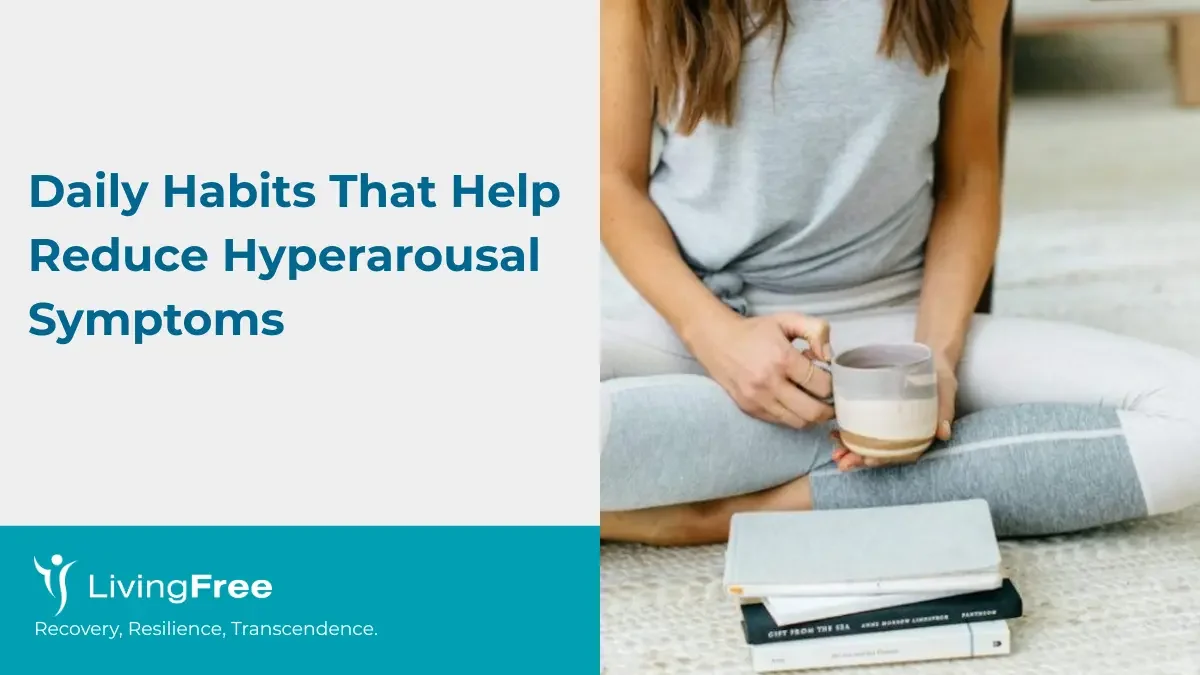Hyperarousal is a state where the nervous system becomes stuck in constant alert mode, even when no real danger is present. It commonly appears in people experiencing chronic stress, anxiety disorders, or trauma-related conditions such as PTSD. When the sympathetic nervous system stays overactivated, both body and mind struggle to return to a calm baseline.
Below, we will deep dive about the daily habits that help reduce hyperarousal symptoms. These small daily actions can support a more stable, peaceful nervous system.
What Hyperarousal Feels Like
Hyperarousal affects both physical and emotional functioning. Many people describe it as feeling “wired,” “tense,” or “unable to switch off.” It can make even small stressors feel overwhelming.
Common hyperarousal symptoms include:
- Feeling constantly on edge or unable to relax.
- Difficulty falling or staying asleep.
- Exaggerated startle response.
- Muscle tension, restlessness, or trembling.
- Fast heart rate or rapid breathing.
- Irritability or sudden anger.
- Hypervigilance (scanning for danger).
- Difficulty focusing or thinking clearly.
Left unmanaged, hyperarousal can disrupt sleep, lower emotional regulation, weaken immunity, and prevent the body from recovering from stress.
Why Daily Habits Matter
You cannot “force” the nervous system to calm down instantly, but you can retrain it through repeated, predictable cues of safety. Daily habits work by gradually lowering your baseline stress level, softening physiological reactivity, and helping the body shift back into the parasympathetic (rest-and-digest) system. Over time, this reduces both the frequency and intensity of hyperarousal episodes. Below are the most effective daily habits to help your nervous system stabilize and remain calmer throughout the day.
Daily Habits to Reduce Hyperarousal Symptoms
1. Practice Slow Diaphragmatic Breathing
Slow, deep breathing activates the parasympathetic (rest-and-digest) nervous system and shifts physiology away from fight-or-flight.
How To Do It
Sit or lie comfortably. Inhale slowly through your nose for 4 counts, let your belly expand. Pause 1 – 2 counts. Exhale slowly through pursed lips for 6 – 8 counts. Repeat for 3 – 10 minutes; do this when you wake, mid-day, and before bed.
2. Strengthen Your Sleep Hygiene
Poor or irregular sleep worsens hyperarousal and reduces emotional regulation.
How To Do It
Keep a fixed sleep/wake time (even weekends), limit screens 60 minutes before bed, make your bedroom dark and cool, and use a wind-down routine (breathing, reading, low lighting). Avoid heavy meals close to bedtime.
3. Move Your Body Daily
Regular exercise reduces physiological arousal, releases endorphins, and helps discharge built-up energy. Mind-body practices (yoga, tai chi) combine movement with breath and improve self-regulation.
How To Do It
Aim for 20–40 minutes most days: brisk walking, cycling, or a short run. Twice weekly, add a 20–30 minute yoga or tai chi session to focus breath + body.
4. Use Grounding and Sensory Techniques
Strong sensory input can interrupt panic-like hyperarousal and bring attention back to the present.
How To Do It (Fast Tools)
Suck a sour candy, hold ice or splash cold water on your face, hum or sing (vagus nerve stimulation), or name 5 things you can see/hear/touch (5-4-3-2-1 grounding). Keep a small “sensory kit” (mint, coin, textured fabric) for moments of high arousal.
5. Incorporate Short Mindfulness or Meditation Sessions
Mindfulness reduces rumination, improves present-moment awareness, and lowers baseline arousal over time.
How To Do It
Start with a 5-minute guided breath awareness practice each morning. When stressed, do a 2-minute body-scan: notice sensations from head to toes without judgment. Increase to 10–15 minutes as comfortable.
6. Practice Progressive Muscle Relaxation (PMR)
Tensing then releasing muscle groups reduces bodily tension that maintains hyperarousal.
How To Do It
Lie down. Tense one muscle group (feet) for 5 – 7 seconds, release for 15 – 20 seconds. Move upward (calves, thighs, abdomen, chest, arms, shoulders, jaw). Finish with slow breathing.
7. Reduce Stimulants and Limit Alcohol
Caffeine and nicotine increase physiological arousal; alcohol disrupts sleep and can worsen anxiety long-term. You can find more about which Foods That Calm the Nervous System & Reduce Hyperarousal, and which make it worse as well.
How To Do It
Track intake for 1 week. Move caffeine earlier in the day (none after 2 pm ideally). Reduce alcohol and replace with non-caffeinated calming beverages (herbal tea).
8. Use Calming Music or Sound Therapy
Specifically structured music can entrain slower breathing and reduce physiological arousal.
How To Do It
Use slow, ambient music during relaxation sessions or an app that guides breathing with sound. Consider 6 breaths-per-minute paced tracks for brief sessions.
9. Maintain a Predictable Daily Routine
Predictability reduces stress hormones and provides a sense of control that lowers baseline hypervigilance.
How To Do It
Create a simple daily plan with wake time, 1–2 focused work blocks, movement breaks, and a wind-down routine. Use reminders and small rituals (tea at 3 pm, 10-minute walk after lunch).
10. Spend Time in Nature and Natural Light
Morning daylight supports circadian rhythms and outdoor time lowers cortisol.
How To Do It
Aim for a 10 – 20 minute walk outside in natural light each morning, even on cloudy days. If possible, take breaks outside during the day.
11. Seek Gentle Social Interaction
Supportive, low-pressure interactions help down-regulate the nervous system and provide perspective.
How To Do It
Schedule a weekly low-stakes meet-up, phone call, or check-in with a trusted friend. Prefer short, positive activities (tea, shared walk).
12. Reflect Through Short Daily Journaling
Writing about stressors reduces intrusive thoughts and clarifies triggers, which helps plan preventive strategies.
How To Do It
Each evening, jot for 3–5 minutes: what triggered stress, what helped, one thing you did well. Use entries to spot patterns (sleep loss, coffee, certain situations).
Quick action plan (first 7 days)
Day 1: Start diaphragmatic breathing (3× daily) + 10-minute evening PMR.
Day 2: Fix sleep schedule; remove caffeine after 2 pm.
Day 3: 20-minute brisk walk; try a grounding sensory kit.
Day 4: Add 5 minutes of morning mindfulness.
Day 5: Try a calming music track (6 breaths/min pacing) before bed.
Day 6: Note triggers in a one-line journal entry each evening.
Day 7: Review patterns, keep what worked, repeat next week.
When to get professional help
If hyperarousal is frequent, severe, or interfering with work/relationships or you have panic attacks, intrusive memories, nightmares, or suicidal thoughts, seek professional help, or you can contact us here. A combination of trauma-focused therapy (e.g., CBT, EMDR), medication, and the daily habits above is often most effective.
Final Thoughts
Hyperarousal can be physically exhausting and emotionally draining, but the nervous system is adaptable. By practicing small, consistent daily habits, you create gentle signals of safety that over time recondition your stress response. These habits don’t replace professional treatment when needed, but they provide a crucial foundation for long-term nervous system regulation, emotional stability, and resilience.
Related Reading:


